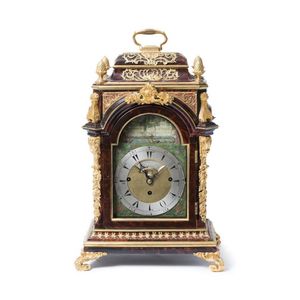Ornate Dutch Zaanse Wall Clock with Atlas Figure
You must be a subscriber, and be logged in to view price and dealer details.
Subscribe Now to view actual auction price for this item
When you subscribe, you have the option of setting the currency in which to display prices to $Au, $US, $NZ or Stg.
- Chapter Ring - A separate metal plate on the face of a clock, on which the numerals for the hours and sometimes parts of the hours, are displayed, usually wheel shaped and sitting on top of the dial plate. The chapter ring is often a feature of the clock and can be silvered or enamelled to stand as a contrast to its background. The hours are usually shown in Roman numerals, although in the late 19th and earlt 20th century, Arabic numerals became fashionable.
- Pendulum - The pendulum was discovered around 1602 by Galileo Galilei, and was adopted for time keeping by the Dutch mathematician and natural philosopher, Christiaan Huygens, who excelled in astronomy, physics, and horology.
The pendulum comprises a metal rod usually of brass or steel with a metal disk, known as a bob, at the end. The movement of the pendulum is driven by weights or a spring, and as a pendulum swings in a regular arc, it was found accuracy could be controlled to within a few seconds a week.
Timekeeping can be adjusted by changing the height of the bob on the rod, making the pendulum either swing slower or faster.
The disadvantage of the pendulum was that changes in temperature also changed the length of the pendulum, interfering with the accuracy of the clock, and so in the 18th century two types of mercurial pendulums were invented which countered the movement in the steel rod.
The pendulum was the world's most accurate timekeeping technology until the invention of the quartz clock, regulated by a quartz crystal, in 1927.
This item has been included into following indexes:
Visually similar items

A 18th century French Boulle large bracket clock, the domed top with figured finial of a Neptune seated upon globe, the arch top door enclosing the gilded dial with white enamel hour panels with cobalt blue Roman numerals, the pendulum suspends in front of

A scarlet faux boulle bracket clock in the Louis XIV style 58 cm high

A black marble mantle clock, circa 1880, American, with maker's mark for Ansonia, with architectural styling, with a visible escapement, the enamel dial with Roman numerals enclosed by a gilded bezel and set within a plinth with a volute and triangular ped

A fine George III ormolu-mounted tortoiseshell veneered striking musical automaton table clock, made for the ottoman Market by Markwick Markham, London, triple fusee movement, verge escapement with a select lever at three on the side of the dial, each side
